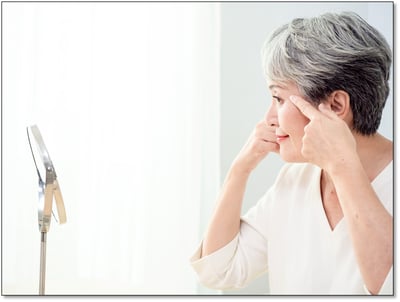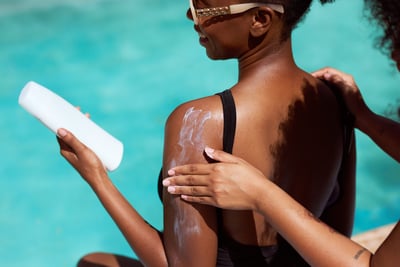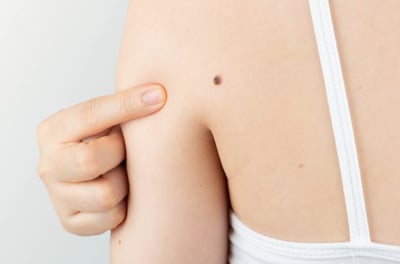
While skin cancer is the most common cancer in the United States, it is also one of the most treatable and preventable. With early detection and proper treatment, skin cancer has a very high cure rate. While there is no sure way to guarantee you won’t get skin cancer, there are things you can do that can lower your risk.
The most important things you can do to protect yourself from skin cancer are to practice preventative care by following these tips.
- Have an Annual Skin Cancer Screening
A skin cancer screening is a visual inspection of your skin by a board-certified dermatologist specially trained to detect skin cancer in its earliest, most treatable stage. No blood work is conducted at a screening. You may be wondering what a skin cancer screening will be like and how long it will take. When you see your local Forefront dermatologist for a complete skin check-up, you can expect a 10-15 minute visit, including a review of your medical history and a head-to-toe skin examination. At this time, let your dermatologist know about any spots you are worried about; your dermatologist can teach you what to look for in the future if you’re not sure, such as any changes in the size, color, borders, or shape of a mole. Also remember that skin cancer may occur on any area of skin, NOT just where you have had sun exposure. Any notable changes in a mole should be checked out. Typically, a spot that the doctor suspects is cancerous will be biopsied. During a biopsy, a sliver of tissue is removed for evaluation by a pathologist, who confirms (or refutes) the dermatologist’s suspicions. - Conduct Monthly Skin Cancer Self-Evaluations
The Skin Cancer Foundation recommends that everyone practice monthly head-to-toe self-examinations of their skin, so that they can find any new or changing lesions that might be cancerous or precancerous. Conduct these monthly skin self-evaluations at home. This quick 5-minute procedure could be life-saving. You can have your dermatologist give you an initial lesson on performing a skin examination and you can also learn how to perform one here. This will help you to monitor any changes in spots on your body and bring them to your dermatologist’s attention as early as possible. - Avoid Intentional Tanning and Using Indoor Tanning Beds
Avoid intentional tanning of your skin and especially sunburn whenever possible. According to Dr. Mark Jackson, MD, a board-certified dermatologist with Forefront Dermatology in Louisville, Kentucky, “People who spend a great deal of time in the sun or allow their skin to burn have an increased risk of developing skin cancer. A sunburn or a tan causes damage to your skin that can show up many years later in the form of wrinkles and even skin cancer. Indoor tanning beds are just as dangerous, if not even more dangerous, than the regular sun because they expose your skin to dangerous UV Rays.” Stay indoors or look for shade in the middle of the day when UV radiation is strongest, usually between 10 AM and 4 PM. Seek shade under an umbrella, tree or other shelter to seek relief from the sun. Cover up with long-sleeved shirts, long pants, wide-brimmed hats, and sunglasses for the best protection against UV radiation. - Keep Children and Especially Newborns Out of the Sun
According to the Skin Cancer Foundation, just one sunburn in childhood more than doubles a person’s chances of developing melanoma later in life. Infants 0-6 months should be kept out of the sun completely. Their skin is too sensitive for sunscreen. Babies 6-12 months are now able to be exposed to very limited sun when completely protected by a broad-spectrum sunscreen with an SPF of 30 or higher. Protecting toddles and older children requires a little more thought and effort. It is important to educate your children and caregivers as well. Look for broad-spectrum sunscreens with an SPF 30 or higher. Water-resistant, spray-on sunscreens are a good choice for toddlers who won’t sit still. Spray sunscreens should not be applied directly to the face; sprays should be misted into the hands, and then spread on the face. Even in the fall and into the winter, it is still important to practice sun safety, especially for babies and children. Keep them indoors between 10 AM and 4 PM, cover them up with protective clothing, and stay in the shade whenever possible. - Continue Using Sunscreen Year-Round
If you can’t cover up completely, be sure to use a broad-spectrum sunscreen with a sun protection factor (SPF) of at least 30 on all exposed skin throughout the year. Sunscreen with a sun protection factor of at least 30 filters out ultraviolet rays, reducing the risk of sunburn. Adults and children should use a broad-spectrum sunscreen containing ingredients designed to filter dangerous ultraviolet rays, as recommended by Skin Cancer Foundation.
Your Local Skin Cancer Experts at Forefront Dermatology are Here to Help
If you or a family member would like to have a skin cancer screening or have a skin concern find the Forefront dermatologist nearest you to schedule an appointment or to learn more.





